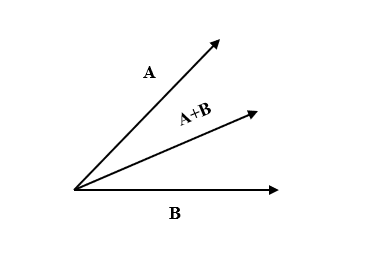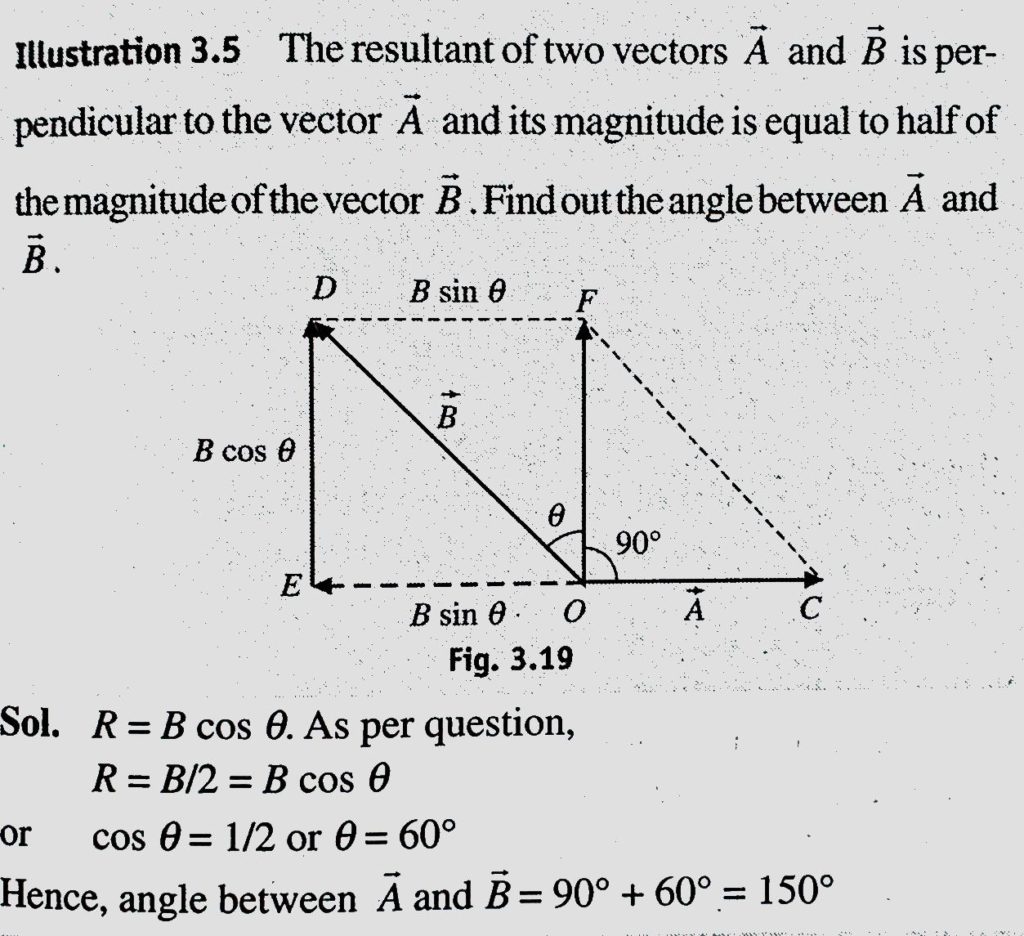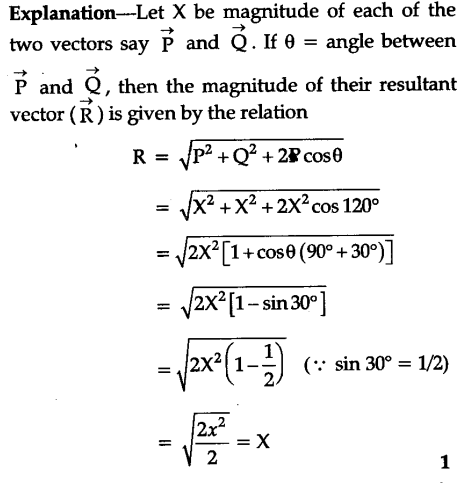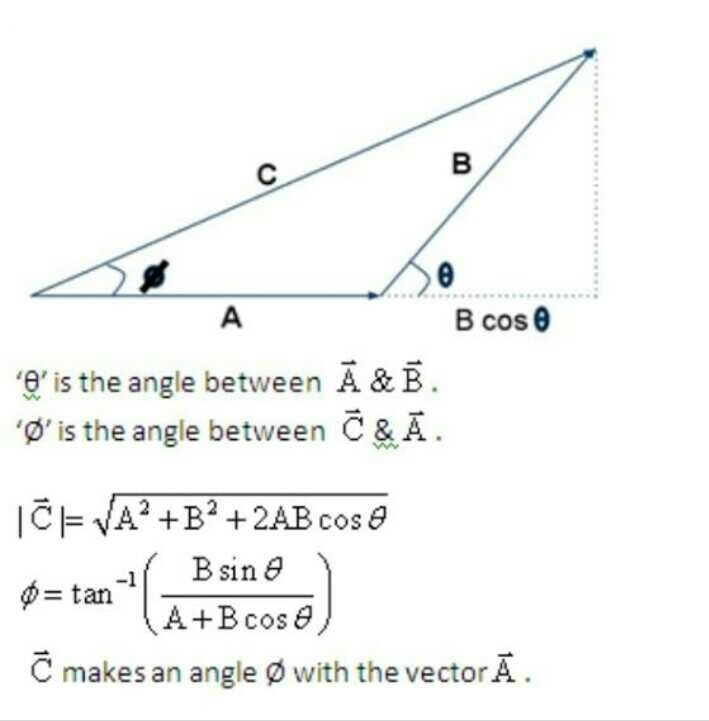Resultant Of Two Vectors Of Equal Magnitude A Is
If is reversed and added to resultant has a magnitude units. The angle between A and B is The angle between A and B is 1 120.

Two Vectors Having Equal Magnitude Of 5 Units Have An Angle Of 60 Between Them Youtube
No it is impossible for the magnitude of the sum to be equal to the sum of the magnitudes.

Resultant of two vectors of equal magnitude a is. The resultant of two vectors A and B is perpendicular to vector A and its magnitude is equal to half of the magnitude of vector B. Thus the vector sum of the three vectors is zero. Three vectors can give zero resultant but two vectors can not.
Is their resultant then Related Videos. Vectors lie on the same plane Collinear. The resultant of two vectors can be found using either the parallelogram method or the triangle method.
The resultant of two vectors A and B is perpendicular to the vector A and its magnitude is equal to half the magnitude of vector B The angle between A and B. This can happen if the resultant of the two vectors are equal and opposite in direction to the third vector. Yes it is possible to add three vectors of equal magnitudes and get zero.
No two vectors of different magnitudes can not give zero resultant. Tamil Nadu Board of Secondary Education HSC Science Class 11th. The resultant of two vectors A and B is perpendicular to vector A and its magnitude is equal to half the magnitude of vector B.
The resultant of two vectors of equal magnitude is equal to the magnitude of either. Yes the angle between resultant vector and either of the vectors will be 45 but the magnitude of Resultant vector in such a case will be sqrt2vecAsqrt2vecB neq vecAvecB. Direction of resultant is between the two vectors Angle between R with either A or B is always 45 degrees.
Are two vectors of equal magnitude of value x and. The resultant of two vectors A and B is perpendicular to the vector A and its magnitude is equal to half of the magnitude of vector. Two vectors of equal magnitude are inclined at some angle such that the difference in magitude of resultant and magnitude of either of the vectors is times either of the magnitude of vectors.
Two vectors are added the magnitude of resultant is 15 units. This is because the effect of vectors cancels out only when they act in the opposite direction and have the same magnitude. Aug 052021 - Two vectors of equal magnitudes P are inclined at some angle such that the difference in magnitude of resultant of either of the vectors is o.
Find the value of X. Problem The position vector of a particle is vecr. 732 times either of the magnitude of vectors.
If Q is reversed and added to P resultant has a magnitude 113 units. If the angle between them is increased by half of its initial value then the magnitude of difference of the vectors is X P. Resultant of two vectors of equal amplitude is equal in magnitude with one Get the answers you need now.
Two vectors P and are added the magnitude of resultant is 15 units. The resultant of F and a perpendicular to P and equal in magnitude to Q has a magnitude vector A 13 units B 17 units C 19 units D 20 units. The resultant of and a vector perpendicular and equal in magnitude to has a magnitude.
If the angle between them is increased by half of its initial value then find the magnitude of difference of the vectors. Then the angle between A and B is. Textbook Solutions 9728 Important Solutions 1.
EduRev JEE Question is disucussed on. Can sum of two vectors be a scalar. What is the value of P2Q2.
Explain in detail whether for two vectors of equal magnitude is it possible to give a resultant of magnitude equal to their individual magnitude justify your answer mathematically. How do you add magnitude of 3 vectors. If resultant of two vectors of equal magnitude is equal to the magnitude of either vector then what is the angle between these vectors.
If resultant of two vectors of equal magnitude is equal to the magnitude of either vector then what is the angle between these vectors. Were always here. If the magnitude of sum of two vectors is equal to the magnitude of difference of the two vectors the angle between these vectors is.
Vectors act along the same line of action Concurrent. Join to connect with other students 247 anytime night or dayJoin Here. Find the magnitude and direction of the resultant vector.
The sum of two or more vectors is called the resultant. The resultant of two vectors A and B is prependicular to the vector A and its magnitude is equal to half of the magnitude of the vector B. If two ropes are attached at one end and say a 1 N force is applied to each of those ropes then the ropes are set 120 degrees apart then the resultant force will be 1 N in a direction bisecting the angle between them.
If vecB is reversed then resultant is of magnitude Q. Resultant of two vectors vecA and vecB is of magnitude P. Two vectors have equal magnitudes of 10 m.
When two vectors act along the same direction the magnitude of their resultant is 10 units.

Two Vectors Having Equal Magnitudes A Make An Angle Theta With Each Other Find The Magnitud Youtube

Resultant Of Two Vectors Of Magnitude P And Q Is Of Magnitude Q If The Magnitude Of Youtube

The Magnitude Of The Resultant Of Two Vectors Of Magnitudes 5 And 3 Is 2 What Is The Angle Between The Two Vectors Find 6 Answers Solutions Learnpick Resources

The Resultant Of Two Vectors Makes An Angle Of 60 With One Vec Youtube

Find The Magnitude And Direction Of The Resultant Of Two Vectors A And B In The Terms Of Their M Youtube
What Is The Angle Between Two Vectors Of Equal Magnitude When The Magnitude Of Their Sum Is The Same As The Magnitude Of Each Vector Quora

When Is The Value Of The Resultant Of 2 Vectors Equal To Either Of Them Quora

A Resultant Of Two Vectors Makes 30 With One Vector And 45 With The Other Find The Two Vectors If The Resultant Has The Magnitude 15

The Magnitude Of The Resultant Of Two Equal Vectors Is Equal To The Magnitude Of Either Vector The Brainly In

The Resultant Of Two Vectors A And B Is Perpendicular To The Vector A And Its Magnitude Is Equal To Half The Magnitude Of Vector B The Angle Between A And B

Two Vectors Of Equal Magnitude Have A Resultant Equal Class 11 Physics Cbse

The Magnitude Of The Resultant Of Two Equal Vectors Is Equal To The Magnitude Of Either Vector The Brainly In

The Resultant Of Two Vectors Of Magnitudes 3 Units And 5 Units Is Perpendicular To 3 Units The Youtube

Explain Under What Conditions The Resultant Of Two Vectors Will Be Equal To Either Of Them Cbse Class 11 Physics Learn Cbse Forum

Question Video Finding The Resultant Of Two Vectors Using The Parallelogram Method Nagwa

How To Find The Resultant Of Two Vectors Youtube

How To Show That The Resultant Of Two Equal Vectors Bisects The Angle Between The Vectors Quora

Vector Application Find Magnitude And Angle Of The Resultant Force Youtube

Two Vectors Having Equal Magnitude Of 5 Units Have An Angle Scholr
Comments
Post a Comment